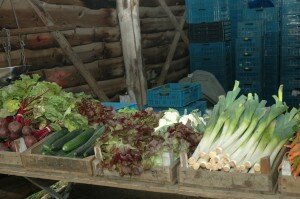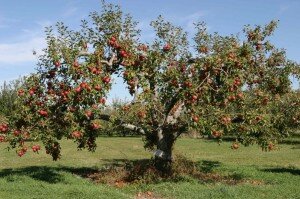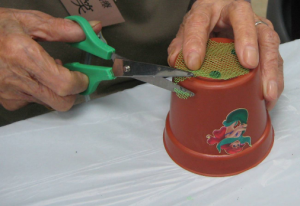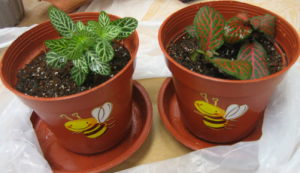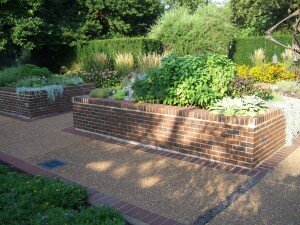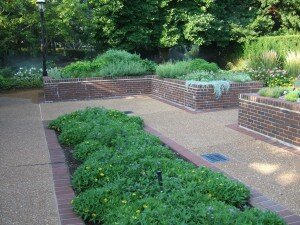In 2012, I had the privilege of serving as an Horticultural Therapy (HT) Intern for CooperRiis and their community. Below I will introduce the CooperRiis mission, share a glimpse into my experience working within a Recovery Paradigm from the Garden, and provide a short summary on the ongoing growth of CooperRiis’ HT Internship program.
-Sarah Barmore Byrd
The CooperRiis Enhanced Recovery Model
CooperRiis: A Healing Community
North Carolina, USA
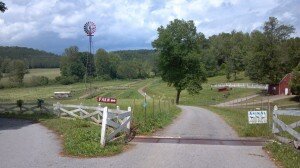
Road to CooperRiis Farm, 2012; Photo courtesy of Sarah Barmore Byrd
“Our healing community rests upon a rich heritage of therapeutic communities in the United States that began in the early 1900’s. The central concept of therapeutic community is to create a living environment in which staff, volunteers, and residents live, learn, recreate, and work together as a functioning community. To this model, CooperRiis has added the elements of modern psychiatry and psychology, with an emphasis on relationship-centered care, recovery, and a strong holistic approach that affirms and honors the whole person.
CooperRiis nurtures the whole person, rather than just the mind by utilizing comprehensive services and experiences such as:
- Therapeutic Community Support of Individual Recovery
- Individual and Group Therapy
- Family Education Program
- Medication Optimization
- Support for Individuals with History of Substance Abuse and/or Addiction
- Community Work and Service Program
- Scholastic Education and Career Assessment
- Integrative Health Counseling and Support for Optimal Health
- Recreational, Cultural, and Arts Experiences”
–The CooperRiis Enhanced Recovery Program: Summary of Philosophy, Program, and Practices— Introduction, p. 1 (2012)
Community Work and Service Program
In 2012, I had the privilege of serving CooperRiis and its residents as a Horticultural Therapy (HT) Intern. Before diving into the community and service, I attended a series of trainings. During this training, I was introduced to the Recovery Paradigm and CooperRiis’ unique Recovery Model built within the paradigm. Within this model Seven Recovery Domains were identified:
- Community/Connectedness
- Spirituality
- Physical Wellness
- Emotional/Psychological Health
- Purpose/Productivity
- Empowerment/Independence
- Intellectual/Learning/Creativity
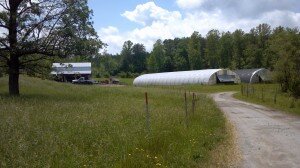
The ‘Potting Shed’, Greenhouse #1 & 2, CooperRiis, 2012; Photo Courtesy of Sarah Barmore Byrd
I initially presumed the work I would do in the garden would be mostly tied to one domain: Purpose/Productivity. It made sense to equate Community Work and Service to Purpose/Productivity. And, in truth, that may be how it was generally categorized– on paper. However, over the course of the summer I began to understand how the garden, in reality, fit within the CooperRiis Enhanced Recovery Program: it grew between all the cracks, and rooted the pieces together. And not by accident, but with deliberate thoughtfulness to design and intention.
The Garden Crew
My skill sets, intern’s purpose and needs led to my assignment within the Community Work and Service Program as a Garden Crew Staff Member and Life Coach. My main task was to assist the permanent Garden Crew Staff in the planning, facilitating and guiding of Garden Crew activities and work hours.
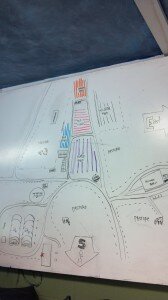
Residents’ Reference Diagram of CooperRiis Farms, Color-coded, 2012; Photo Courtesy of Sarah Barmore Byrd
In addition to this task, I would also attend the weekly meetings of the Garden Crew Staff with Farmer Mike (the head guru of Farm operations) to discuss the constantly changing activity schedule in the garden and attend all extra company training. I would maintain my personal records of HT-related activities and documentation, and meet with my HT adviser weekly. Then, lastly, I would, after some shadowing, be slowly assigned to incoming residents joining the Garden Crew, as their Life Coach.
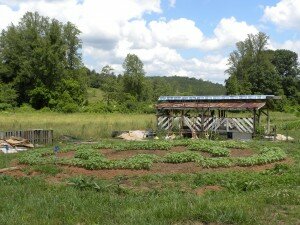
The Sunflower Group Reflection Circle–in Growth, CooperRiis, 2012; Photo Courtesy of Sarah Barmore Byrd
It was in this role that the compatibility of Gardening and the Recovery Model became the most apparent to me.
A Recovery Paradigm in the Garden
As a Life Coach you attend your assigned resident’s routine meeting with all of their case management support. During those meetings, the resident will identify ways each of their case management members can offer support towards their personal goals. The Life Coach’s capabilities to serve in this capacity are, for obvious reasons, mostly tied to their Work Crew roles. This resulted in Life Coaches giving support centered around aiding in their resident’s timely arrival to work hours, completing their work tasks, embracing their work and finding pride in their completed work. The work in this case meaning gardening, sweat and conversation, and the work output; harvest, health and beauty.
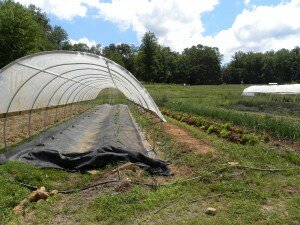
The ‘Red’ Field, CooperRiis, 2012; Photo Courtesy of Sarah Barmore Byrd
Yet, the support and work did not stay within the rows or beds of the garden spaces. Work and support ebbed and flowed from the morning breakfast, to community meetings, to drum circles, to flower arranging for the public eating areas. The blossom of recovery, that I believed would neatly occur at separate locations in different fashions–in truth seemed to spread all over and build on itself.
The garden, I realized, is a perfect vehicle for the kind of recovery process facilitated by CooperRiis’ Recovery Model. Gardening has long fingers that stir the spirit, fill your table, strengthen the body, induce kindness, tease out laughter, teach skills, bring peace, spur the mind to reason, and… can bring strangers close.
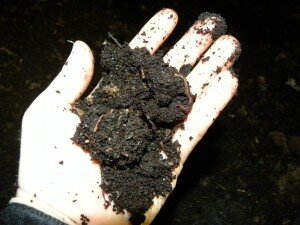
CooperRiis Vermiculture Bin Product, 2012; Photo Courtesy of Sarah Barmore Byrd
9 acres of the CooperRiis campus devoted to soil, vegetables and sweat, seemed to me, an effective mechanism to give those who felt kinship with the ground a chance to embrace the CooperRiis Recovery Program in a way that brilliantly interlocks all seven recovery domains.
2012 Onward: The CooperRiis HT Internship Program Bearing Fruit
Typically, my case included, HT Interns discover CooperRiis’ Internship program by a mix of good fortune and word of mouth. However, due to CooperRiis’ recent showcase at the 2011 American Horticultural Therapy Association (AHTA)’s Annual Conference, their Mill Spring campus has had an ever steady stream of HT Intern applicants eager to work in the Garden. Some are attracted to CooperRiis because of its ability to board them throughout their internship–while others want a chance to gain the unique immersive community experience that CooperRiis offers.
In 2013, CooperRiis offered its campus, housing, food (delicious, nutritious, down-right awesome–and did I mention 10% [2012] of it all comes from their Garden??) and work experience to at least three different HT interns, each with a typical stay of a 3 month period, working full-time. Over the three month period, each intern is charged with managing their own internship needs and building on the internship’s experience before them.
Since I have been there, the internship program has keep pace with the evolving AHTA standards offering more opportunities for the HT Interns to work in formalized goal-setting groups and providing HT therapy-rich group experiences. In addition, HT Interns have improved the CooperRiis campus by redefining and building on outdoor places for recovery, and has added literature* to the growing body of outcome research from CooperRiis.
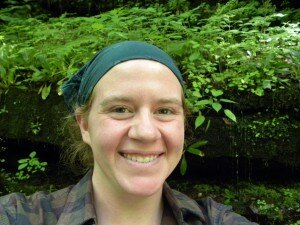
-A Glimpse into the CooperRiis HT Intern Experience, 2012, Sarah Barmore Byrd
*The PPC Newsletter Team is in the process of trying to locate information on the HT Intern projects… stay tuned.
For more information on CooperRiis’ HT Internship program, contact: Lisa Schactman at [email protected].
For more information on CooperRiis and their mission you can visit their website or view their Outcomes Research Summary published in January 2013.


